Onychomycosis is a fungal damage to the nails. The disease can be caused by dermatophytic fungi or microsporia. The fungus negatively affects the construction base of the nails - keratin and gradually eating it causes changes in deformation.
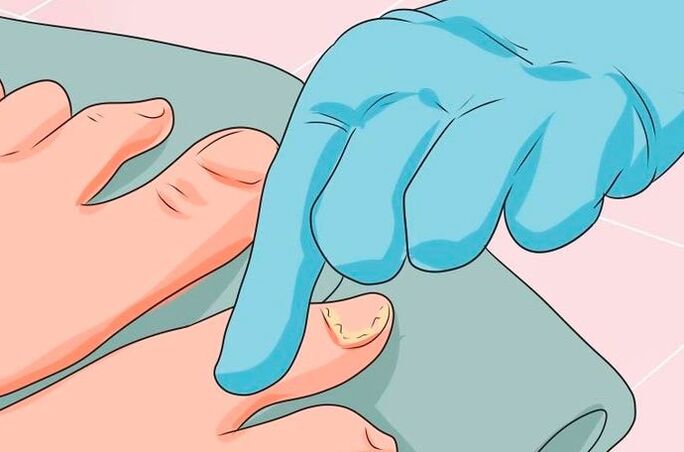
There are the following types of onychomycosis:
- Normorophic. Changing the color of the nail, the appearance of stripes and spots.
- Hypertrophic. Not only the color change, but also a slight deformation comes. Most often the nail is deformed from the edges.
- Onycholithic. The nail is destroyed, atrophied and rejected.
The fungus on the toenails appears not only due to a decrease in immunity. About 70% of people are infected by a sick person and most often they are a relative. The smallest scale of the skin from the feet fall on household objects and in contact with healthy nail or skin tissues infect a healthy person.
Most often the infection occurs through:
- Towel.
- Mushrooms.
- Towels.
- Carpets.
- Shoes.
- Manicure accessories.
When you visit the beach, the sauna and the slippers without slippers, there is a high risk of infection with a fungus of the legs. With high humidity and temperature, the infection is much more common.
It is especially careful to be in public where people go barefoot. The fungi are resistant to both low and high temperature, and in beach sand they retain their viability for several months.
Healthy tissues are gradually influenced by a fungus. Much depends on what type of pathogen, but some signs allow us to distinguish several basic stages of the development of onychomycosis:
- Normorophic or original. At this stage, there are no pronounced manifestations, at this stage it is difficult to notice an infection with a fungus. The nail becomes matt, its color can change slightly, small cracks, irregularities on the surface appear. Burning and itching can be felt. This period is easy to confuse with other diseases: psoriasis, changes in the liver. Therefore, to confirm the diagnosis, it is recommended that you contact a dermatologist.
- The hypertrophic form occurs if the measures are not taken at the initial stage. Symptoms are becoming more pronounced. The nails thicken and darken, the shape of the plate is deformed, it decays and destroyed.
- Atrophic or neglected. It seems when the infection extends to the cuticle, the latter rejects, inflams and swells. The entire surface of the nails changes color, it is completely separated from the bed. Treatment can be ineffective, the nail is not always saved due to its atrophy.

Signs of nail fungus:
- The nail plate begins to change the shade, it becomes boring. As a result, it loses a healthy pink color. When the fungus parasitizes on the surface, the nail turns white or yellowish. So it most often happens on the fingers. With other types of damage, nails can acquire any shade: from greenish, gray to black.
- Thickening or depletion of nails - when you notice that the thickness of the nail has changed, this is a clear sign of fungal damage. At the same time, the nail plate loses elasticity, becomes rough, tough or back too soft, starts to fall apart. The normal thickness of the nail of the fingers does not exceed 0, 5 mm, the toenails up to 1 mm.
- Stratification of the nail plate, its lagging from the surface of the nails is a sign of an advanced stage of the disease when the structure of the nail changes. It becomes loose, uneven, covered with grooves.
- Discomfort - To understand that a fungus has appeared on the nails through unpleasant sensations that accompany this disease. There is severe itching, sometimes painful sensations.
- Unpleasant odor - this symptom is especially characteristic of onychomycosis of the toenails. When they start to smell unpleasant, despite the regular behavior of hygiene procedures, you should see a doctor.
Nail fungus is often accompanied by an extremely unpleasant odor
The common symptoms of the disease are listed above. But how specific the onychomycosis manifests depends on the type of fungi that impressed the nails.
Each variety of mycosis has typical signs:
- Fleet mushrooms - leads to rapid thinning of the nails. It becomes broken, starts to exfoliate from the nails. The shade of the nail first turns yellowish, and then turns brown. With the neglected form of the disease, the skin around the nail swells, blushes.
- Forms - parasitize on the surface of the nails without penetrating deeper. Thanks to this type of disease, it is easier to treat than others. The main sign of the disease is a change in the color of the nail. The shade can be anyone: from white, green to gray, black. If you do not start proper treatment in a timely manner, the fungus spreads to other nails and even the skin. There is severe itching, pain, especially when walking.
- Dermatophyte - develops when the nail is influenced by Trichophyton spp. , As well as Epidermophyton spp and Microsporum spp. The first signs of this disease - spots or stripes of gray, yellowish tint are formed on the nails. As the disease progresses, their amount increases and the nail begins to exfoliate.
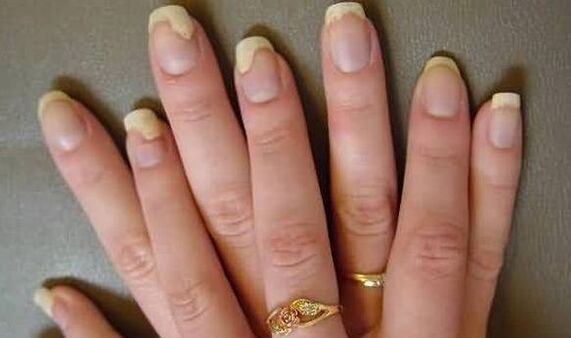
Dermatophyte one of the common forms of nail fungus
To know what kind of mycosis was struck by the nail very important for proper treatment. The active components of most pharmacological drugs are designed to destroy a specific type of fungus.
Onychomycosis begins with the lesion of insignificant parts of the nail, so many people do not at first pay attention to the change in the shade and the formation of spots. In the absence of treatment, mycosis spreads quickly enough, affecting all large areas of the infected nail, moving to healthy nails and infecting others.
There are 3 stages of nail mycosis development:
- The initial stage - goes without clear symptoms, uncomfortable sensations such as itching, pain, are often absent. Nails of the nails appear small spots, stripes, interweaves, which are barely different. It is easiest to notice them on the thumb.
- The second or progressive stage of onychomycosis - the number of spots and channels increases, they become large and are already clearly noticed. The color of the nails changes, fades and begins to deform.
- The advanced stage - the nail plate completely loses the aesthetic appearance, it is too thick or very fragile. The color of the nail turns yellow, brown, green, black. It exfoliates, there is a risk of complete loss of the nail.
The first signs of the presence of nail fungus
The earlier it is possible to detect onychomycosis, the greater the likelihood of getting rid of this disease. With competent surgery therapy, the body suffers minimal, so when the first symptoms of mycosis occur, you should consult a doctor.
The first signs of nail mycosis appear almost immediately after the infection. If after visiting public places such as a pool, sauna, shower in the gym, beach, nails fade, they began to itch a little, then these may be the first signs of onychomycosis.
Healthy nails are practically not susceptible to fungal infection. It begins to develop rapidly when it is only on damaged nail plates.
Folk remedies
There are many folk remedies that will help to cure the nails affected by a fungus at the initial stage. Think of effective but simple recipes at the same time.
Sometimes ordinary iodine can quickly handle the sponge
- Iodine - daily, until the symptoms disappear, apply 1 drop of iodine 5% on the affected nails. The procedure is performed in the morning as well as in the evening. More material for the treatment of iodine.
- 1 teaspoon of iodine, vinegar, glycerol is mixed and diluted with 6 teaspoons of water. The resulting mixture for 10 days in a row rubs the nails. The composition of the nails should be left overnight.
- Vinegar - Prepare a bath by diluting 1 part vinegar 9% with 8 parts hot water. To rise to your feet or hands for 20 minutes. Perform 7 procedures every other day. More material for the treatment of vinegar.
- Egg ointment - Put a raw chicken egg in the shell in a glass and pour 9%vinegar to the top. When the shell is dissolved, remove the remaining film and mix the egg with vinegar. The resulting mixture is applied twice a day to the affected areas for 2-3 weeks.
Chicken eggs are also quite effective against nail mycosis
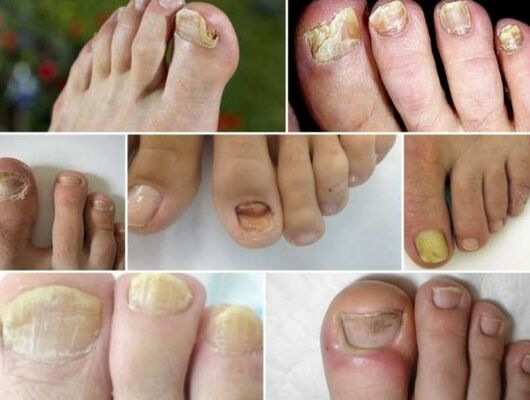
- Hydrogen peroxide - Dilute in 2 liters of water 2 tablespoons of hydrogen peroxide 3%. To elevate your hands or feet, depending on where the fungus is localized for 20 minutes. Repeat the procedure for 7-10 days in a row.
- Peroxide compress - To impregnate a cotton peroxide, attach it to the nails on which there are signs of the fungus. Before that, arms or legs should be scared in the bathroom with soda. To prepare it, 1 teaspoon of baking soda is diluted in 1 liter of water. The compress on top is wrapped with cellophane or food film and left for 60 minutes. This is necessary so that the peroxide does not evaporate. Repeat the procedure for 10-14 days twice a day.
- Propolis tincture - wet a cotton swab into the alcohol tincture of Propolis 20% and attach to the affected areas. Keep the lotion until the composition dries. Repeat daily until recovery. 1-2 procedures are sufficient per day.
- Laundry powder - the method is suitable for the treatment of toenails. It is necessary to dissolve 100 g of laundry powder that contains many alkali, in 2 liters of water. Hold in such a bath for 15 minutes. Repeat 10-14 procedures until the symptoms disappear.
- Garlic - Cut the peeled garlic clove, wet in salt and then grate your nails. Repeat twice a day before the symptoms disappear.
- Ammonia - diluted in 1 glass of water 1 tablespoon ammonia. The resulting solution is impregnated with cotton fabric. You need to wrap your legs or hands and leave this compress at night. Repeat the procedure for 7 days each day.
- Onion - Grind the onion until the porridge consistency and attach to the affected nails for 30 minutes. Repeat twice a day before recovery.
Sliced onion will help you bring back your nails healthy
- Mix chamomile, sage mint, you can take dry or fresh herbs. Place the resulting composition in a finger or glove at night. Herbs should change every night. Repeat the procedure in combination with other recipes until the fungus symptoms disappear.
- Boric acid - cotton swabs impregnated with boric acid, are used for pre -left nails. You should keep the lotion for 30 minutes. The procedure is repeated for 10 days in a row every day.
- Celendin Oil and Tea Tree - Mix these products in the same proportion, soak the gauge gang with the resulting composition and apply it to the nails for 20 consecutive days for 45 minutes. The recipe is contraindicated in pregnant women.
- Soda - Dilute soda with a small amount of water to the consistency of offices. Apply it to the nails for 20 minutes and then rinse with warm water for 10-12 days twice a day.
- Apple cider vinegar - dilute it with olive oil. The required proportion is 2 parts vinegar up to 1 part of the oil. Apply the mixture to the affected nail plates until the nail is fully grows.
- Tea Tree Oil - Apply a few drops of oil to the nails until the areas of the nails affected by the sponge will grow completely.
- Verba - Grind 500 g of young willow shoots, pour 2 liters of water, bring to a boil. From the finished decoction three times a week, make hand or leg baths for 20 minutes until recovery.
- Nettle - Prepare 3 tablespoons of nettle in 400 ml of water. With this decoction, take wet swabs and apply them to the nails twice a day before the recovery.
- Grind the mountain ash leaves and put the nails with a thick layer and then wrap it with a baking movie for 30 minutes. Repeat the procedure daily for 12-14 days.
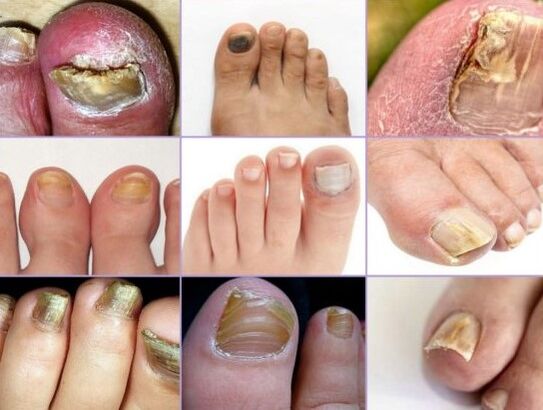
- The fungus of the skin of the feet.
- Reducing immunity.
- Family members suffering from fungal lesions.
- Old age.
- Diabetes.
- The presence of micro -traumas and storms.
- Increased sweating of the legs.
- Unknown and bad -quality shoes.
- The habit of going barefoot in public places.
- Accommodation and work in a humid climate.
- Long -term wearing artificial nails.
- General health.
- Sensitivity to infection.
- Moisture level and heat background.
- The nail appearance (finger nails grow more slowly).
- Distal submarine onychomycosis.
- Lateral onychomycosis.
- Onychomycosis on the white surface.
- Proximal tray onychomycosis.
- General dystrophic onychomycosis.
How can you get an infection with a fungus?
Nail mycosis infection can happen anywhere: from places to visit your own home. It is transmitted directly from people to people, as well as through objects with which a person suffering from mycosis contacts. The fungus penetrates micro -cracks, bruises, other damage.
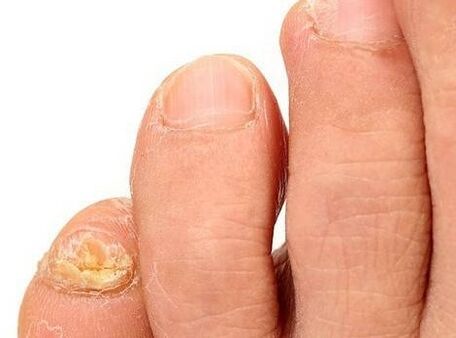
Places you can get infected with mycosis:
- Public places where people often go barefoot, especially if humidity increases there. In such a microclimate, Mikoz has retained its life for a long time. Examples of such institutions are souls in fitness centers, saunas, baths.
- Chests in stores, sports complexes and other places.
- Manicure Rooms - If the Master does not process the tools poorly after having done a manicure or pedicure of a person with a sponge, the next client is very likely to be infected with the disease.
- Visiting at home - when a person puts clothes, shoes where the fungus remains, uses a towel he used to use from onychomycosis. The fungus can be on the nails if you walk barefoot on the floor.
- Beach - there is always a lot of mushroom controversy in the sand on the beach. If you walk barefoot, they will penetrate the micro -cracks and the diseases cannot be avoided. In addition, you can get infected on the beach through a deck chair.
- Public transport - through the railings that the patient touched.
- Shop - As I tried the bare foot of the shoes, which previously measures the patient with a nail sponge.
There is a great chance of getting infected with a nail sponge in public transport
In the above places you should be extremely neat to avoid infection.


















